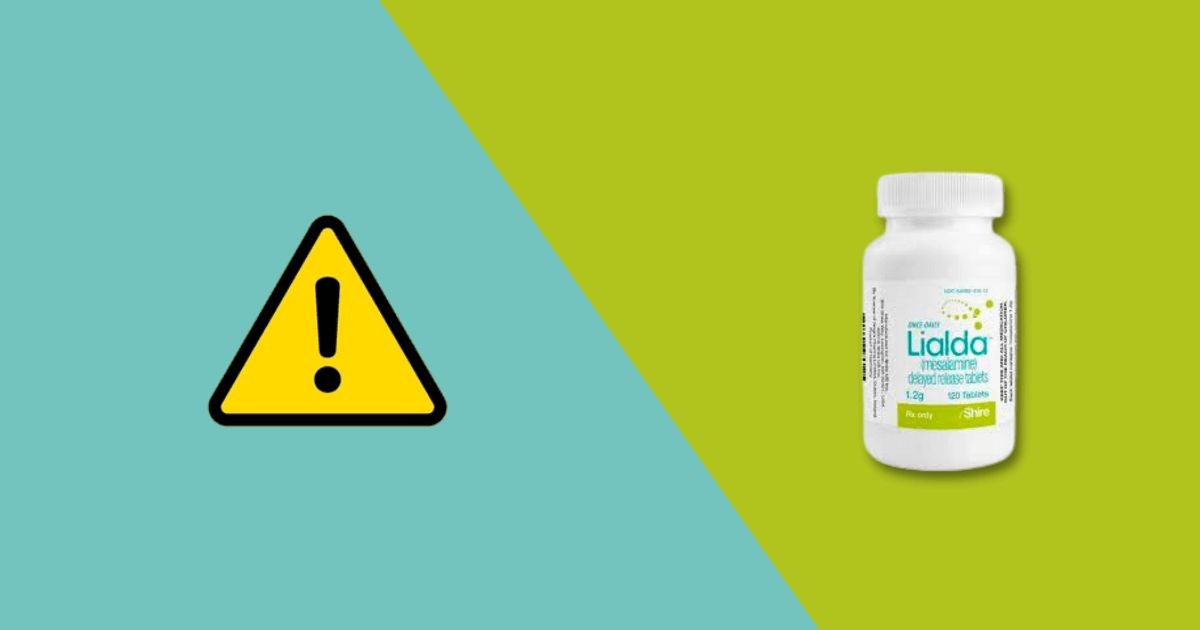
Contents
Side Effects of Lialda (mesalamine)
Lialda (mesalamine) is an anti-inflammatory agent used to treat active, mild to moderate ulcerative colitis.
Lialda is mesalamine in a form that is slowly released in the intestine so that it can be given just once-a-day. Other oral drugs containing mesalamine that are similar to Lialda include Asacol, Pentasa, and Apriso. Asacol and Pentasa, however, are given as multiple daily doses.
The exact mechanism of Lialda is not known but is believed to be by reducing inflammation in the colon. Ulcerative colitis and other inflammatory diseases cause excessive production of chemicals (i.e., prostaglandins) that produce inflammation in the colon.
Prostaglandins are produced by cyclooxygenase and lipoxygenase enzymes. These enzymes are over-active in individuals with ulcerative colitis. Lialda may work by blocking the activity of cyclooxygenase and lipoxygenase, therefore, reducing the production of prostaglandins. Reduced prostaglandin production reduces inflammation in the colon and other symptoms associated with ulcerative colitis.
Common side effects of Lialda include:
Less common side effects of Lialda include:
Serious side effects of Lialda include:
- pancreatitis,
- blood disorders,
- kidney dysfunction and
- an acute intolerance syndrome that resembles a flare of inflammatory bowel disease. Symptoms include:
- cramping,
- acute abdominal pain,
- bloody diarrhea,
- fever,
- headache,
- itching, and
- rash.
Specific drug interaction studies have not been conducted with Lialda. Other mesalamine medications have been associated with several drug interactions.
Combining mesalamine with drugs that affect kidney function, for example, nonsteroidal anti-inflammatory drugs (for example, ibuprofen), may increase the likelihood of kidney dysfunction. Concurrent use of mesalamine and 6-mercaptopurine or azathioprine may increase the likelihood of blood disorders. Mesalamine may increase the blood thinning effect of warfarin.
There are no adequate human studies of Lialda use during pregnancy. Lialda should only be used during pregnancy if it is felt that the benefit of its use justifies the unknown risks.
Lialda is excreted in breast milk. Lialda should only be used by breastfeeding mothers if it is felt the benefit of its use justifies the risk.
What are the side effects of Lialda (mesalamine)?
The most common side effects are:
Other less common side effects include:
- increased heart rate,
- acne,
- pancreatitis,
- back pain,
- fatigue,
- tremor,
- ear pain,
- blood disorders, and
- kidney dysfunction.
Possible serious side effects include an acute intolerance syndrome that resembles a flare of inflammatory bowel disease. Symptoms include:
These symptoms usually subside once mesalamine is discontinued. Since mesalamine is related chemically to aspirin, individuals who are allergic to aspirin should not take mesalamine.
Lialda (mesalamine) side effects list for healthcare professionals
The most serious adverse reactions seen in Lialda clinical trials or with other products that contain or are metabolized to mesalamine are:
- Renal impairment, including renal failure
- Mesalamine-induced acute intolerance syndrome
- Hypersensitivity reactions
- Hepatic impairment
Clinical Trials Experience
Because clinical trials are conducted under widely varying conditions, adverse reaction rates observed in the clinical trials of a drug cannot be directly compared to rates in the clinical trials of another drug and may not reflect the rates observed in practice.
Adults
Induction
The most common adverse reactions occurring in at least 1% of Lialda- or placebo-treated adult patients with mildly to moderately active ulcerative colitis in two eight-week, randomized, double-blind, placebo-controlled trials (Study 1 and Study 2) are listed in Table 2.
Table 2: Adverse Reactions* in Two Eight-Week, Placebo-Controlled Trials of Induction Therapy (Study 1 and Study 2) in Adults with Mildly to Moderately Active Ulcerative Colitis
| Adverse Reaction | Lialda 2.4 g once daily (n=177) |
Lialda 4.8 g once daily (n=179) |
Placebo (n=179) |
| Headache | 6% | 3% | |
| Flatulence | 4% | 3% | 3% |
| Liver Function Test Abnormal | 2% | 1% | |
| Alopecia | 0 | 1% | 0 |
| Pruritus | 1% | 1% | |
| *Reported in at least 1% of patients in at least one Lialda group and greater than placebo | |||
Pancreatitis occurred in less than 1% of patients during induction in clinical trials and resulted in discontinuation of therapy with Lialda in patients experiencing this event.
Maintenance Of Remission
A Lialda dosage of 2.4 g/day, administered as either 1.2 g twice daily or 2.4 g once daily, was evaluated for safety in three maintenance trials in patients with mildly to moderately active ulcerative colitis: a 6-month double-blind, active-controlled study (Study 3) and two 12- to 14-month open-label studies. The most common adverse reactions with Lialda in these maintenance trials are listed in Table 3.
Table 3: Adverse Reactions in Three Trials of Maintenance of Remission in Adults with Ulcerative Colitis
| Adverse Reaction | Lialda 2.4 g/day† (n=1082)% |
| Headache | 3% |
| Liver function test abnormal | 2% |
| Abdominal pain | 2% |
| Diarrhea | 2% |
| Abdominal distension | 1% |
| Abdominal pain upper | 1% |
| Dyspepsia | 1% |
| Back pain | 1% |
| Rash | 1% |
| Arthralgia | 1% |
| Fatigue | 1% |
| Hypertension | 1% |
| *Reported in at least 1% of patients †Administered either as 1.2 g twice daily or 2.4 g once daily |
|
The following adverse reactions, presented by body system, were reported in less than 1% of Lialda-treated patients with ulcerative colitis in either induction or maintenance trials:
Cardiac Disorder: tachycardia
Ear and Labyrinth Disorders: ear pain
Gastrointestinal Disorders: abdominal distention, colitis, diarrhea, flatulence, nausea, pancreatitis, rectal polyp, vomiting
General Disorders and Administrative Site Disorders: asthenia, face edema, fatigue, pyrexia
Investigations: decreased platelet count
Musculoskeletal and Connective Tissue Disorders: arthralgia, back pain
Nervous System Disorders: dizziness, somnolence, tremor
Respiratory, Thoracic and Mediastinal Disorders: pharyngolaryngeal pain
Skin and Subcutaneous Tissue Disorders: acne, prurigo, rash, alopecia, pruritus, urticaria
Pediatrics
Lialda was evaluated in 105 pediatric patients 5 through 17 years of age with mildly to moderately active ulcerative colitis. The adverse reaction profile was similar to that of adults. The most common adverse reactions reported in at least 5% of pediatric patients treated with Lialda were: abdominal pain, upper respiratory tract infection, vomiting, anemia, headache, and viral infection.
Postmarketing Experience
In addition to the adverse reactions reported above in clinical trials involving Lialda, the following adverse reactions have been identified during postapproval use of Lialda and other mesalamine-containing products. Because these reactions are reported voluntarily from a population of uncertain size, it is not always possible to reliably estimate their frequency or establish a causal relationship to drug exposure.
Body as a Whole: lupus-like syndrome, drug fever
Gastrointestinal: cholecystitis, gastritis, gastroenteritis, gastrointestinal bleeding, perforated peptic ulcer
Hepatic: jaundice, cholestatic jaundice, hepatitis, liver necrosis, liver failure, Kawasaki-like syndrome including changes in liver enzymes
Hematologic: agranulocytosis, aplastic anemia
Immune System Disorders: anaphylactic reaction, angioedema, Stevens-Johnson syndrome (SJS), drug reaction with eosinophilia and systemic symptoms (DRESS)
Musculoskeletal and Connective Tissue Disorders: myalgia, lupus-like syndrome
Renal Disorders: renal failure, interstitial nephritis, nephrogenic diabetes insipidus
Respiratory, Thoracic and Mediastinal Disorders: interstitial lung disease, hypersensitivity pneumonitis (including interstitial pneumonitis, allergic alveolitis, eosinophilic pneumonitis)
Urogenital: reversible oligospermia
What drugs interact with Lialda (mesalamine)?
Nephrotoxic Agents, Including Non-Steroidal Anti-Inflammatory Drugs
The concurrent use of mesalamine with known nephrotoxic agents, including non-steroidal anti-inflammatory drugs (NSAIDs), may increase the risk of nephrotoxicity. Monitor patients taking nephrotoxic drugs for changes in renal function and mesalamine-related adverse reactions.
Azathioprine And 6-Mercaptopurine
The concurrent use of mesalamine with azathioprine or 6-mercaptopurine and/or any other drugs known to cause myelotoxicity may increase the risk for blood disorders, bone marrow failure, and associated complications. If concomitant use of Lialda and azathioprine or 6-mercaptopurine cannot be avoided, monitor blood tests, including complete blood cell counts and platelet counts.
Interference With Laboratory Tests
Use of Lialda may lead to spuriously elevated test results when measuring urinary normetanephrine by liquid chromatography with electrochemical detection. Consider an alternative, selective assay for normetanephrine.
Summary
Lialda (mesalamine) is an anti-inflammatory agent used in the treatment of active, mild to moderate ulcerative colitis. Common side effects include headache, flatulence, hair loss, and itching. Less common side effects include increased heart rate, acne, back pain, fatigue, tremor, and ear pain. Lialda should only be used during pregnancy or while breastfeeding if the potential benefit justifies the unknown risks.


